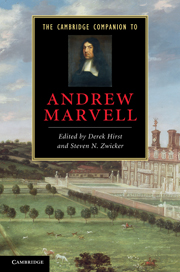Book contents
- Frontmatter
- 1 Introduction
- 2 The social modes of Marvell’s poetry
- 3 Marvell and the literary past
- 4 Borders and transitions in Marvell’s poetry
- 5 Thinking of gender
- 6 Marvell and the designs of art
- 7 Andrew Marvell’s citizenship
- 8 The green Marvell
- 9 A Cromwellian centre?
- 10 The poet’s religion
- 11 Adversarial Marvell
- 12 How to make a biography of Andrew Marvell
- Index
- Cambridge Companions to. . .
4 - Borders and transitions in Marvell’s poetry
Published online by Cambridge University Press: 28 March 2011
- Frontmatter
- 1 Introduction
- 2 The social modes of Marvell’s poetry
- 3 Marvell and the literary past
- 4 Borders and transitions in Marvell’s poetry
- 5 Thinking of gender
- 6 Marvell and the designs of art
- 7 Andrew Marvell’s citizenship
- 8 The green Marvell
- 9 A Cromwellian centre?
- 10 The poet’s religion
- 11 Adversarial Marvell
- 12 How to make a biography of Andrew Marvell
- Index
- Cambridge Companions to. . .
Summary
Andrew Marvell is a writer deeply identified with particular locales and enclosures. Despite recent interest in his occasional and polemical writings, he is still first and foremost the poet of gardens, those lush, mysterious haunts we know so well from The Garden, from Upon Appleton House, To My Lord Fairfax, or from The Nymph Complaining for the Death of her Fawn. More generally we think of Marvell as a pastoral poet, ever attendant to the green business of the world, familiar of Daphnis and Chloe, Ametas and Thestylis, and not least Damon the Mower. His most famous poem, To His Coy Mistress, has as its backdrop the Yorkshire countryside and was likely written, as we believe the great part of his lyrics were, while Marvell was in residence at Nun Appleton. Later in the 1650s, we might think of Marvell in his employ at the Latin Secretary’s Office, perhaps writing there A Poem upon the Death of O. C.; and in the 1660s we might think of him in lobbies and committee rooms of Parliament, writing letters to the Hull Corporation or collecting gossip and slander for the ‘advice to a painter’ poems.
- Type
- Chapter
- Information
- The Cambridge Companion to Andrew Marvell , pp. 46 - 67Publisher: Cambridge University PressPrint publication year: 2010



